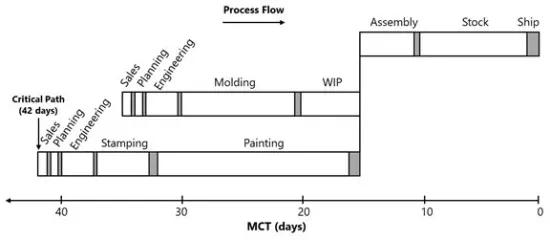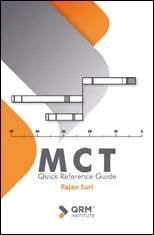Lead time reduction starts with mapping your lead time. The MCT is a handy tool that lets you quickly map out your lead times and gain insights.
Reducing lead time offers numerous advantages. For example, reducing lead times leads to a reduction in inventories, less planning and coordination work, higher delivery reliability, higher customer satisfaction and ultimately less chaos and stress.
However, the term 'lead time' is a flag that covers many loads. Some interpret lead time as the delivery time for the customer, the planned times in the ERP system, the time from goods receipt to shipment, the time from order to invoicing,... Reducing each of these times is interesting in itself, but not all lead time reductions have the same impact. For make-to-stock companies, the delivery time is already very short, so further shortening the delivery time will not have much impact. For make-to-stock companies, on the other hand, the time from receiving goods to shipping can be quite long because their products tend to stay in the warehouse for a long time. Reducing this last lead time will have a lot of impact.
MCT
Correctly defining the lead time is essential if one wants to have an impact by shortening the lead time. In addition, a good definition can also avoid confusion and misunderstandings. A clear and widely applicable definition for the lead time is the Manufacturing Critical-path Time (MCT).
The Manufacturing Critical-path Time (MCT) is defined as 'the typical amount of calendar time when a customer submits an order, through the critical path, until the first end-item of that order is delivered to the customer'. Simply put, this comes down to the time to make a product from scratch until delivery to the customer. For the sake of clarity, let us break down the definition:
- the typical amount of calendar time:
We are not going to look at the best case, but we must choose the typical values. One way to do that is by looking at the average values. In practice, average values are often not as representative, because they are distorted by registration errors that typically appear as very small numbers (zero), or very large numbers. A better way is therefore to calculate the median. The median is less distorted by the extreme values. We also calculate the time in calendar days, so we do not take weekends and holiday periods into account. After all, it doesn't matter to the customer when you work. - through the critical path:
Products are often made up of multiple components with different routings. The critical path corresponds to the longest time path needed to create a product from scratch. The critical path goes through all the steps necessary to produce the components. You may therefore not start from the components that may have been produced in advance. The time in stock is also counted. Non-critical items (such as bolts, packaging material, etc.) are not included in the calculation for the sake of simplicity. These items typically represent a low value, so it is not worth tracking them. - the first end-item:
This part of the definition allows partial deliveries and encourages working in smaller lots. If a customer only orders 50 items once a year, he might consume about 1 item per week. It may therefore suffice to deliver 1 item per week. Smaller deliveries and production batches are an important technique to keep the lead time short. The first end-item should be 'complete' in a sense that the delivery to the customer is also usable for the customer. For a tyre manufacturer, for example, this means that a delivery to a car manufacturer includes at least 4 tyres, because a car needs 4 tyres in order to be completed.
MCT Map
The MCT can also be visualized in a map, the MCT map. The figure below shows an example of an MCT map. The map shows the successive process steps, including the steps to make the components (the branches in the map) that come together at the assembly branch. The time blocks have 2 colors: white is used to visualize the waiting times; gray visualizes the time needed to produce the first part.
The grey time includes both the changeover time and the actual production time of the first part (not the production time of the entire batch). In batch production, one part is typically being produced, while the other parts of the batch are waiting. The grey time is typically only 5% or less of the MCT. Most of the MCT is therefore white time. To put it another way: in most companies, orders wait for an operation 95% of the time. This indicates that there is still a lot of room for improvement. A lead time reduction of 50% or more is therefore no exception.
An MCT map has several advantages:
- The MCT is simple and not overloaded with data. This makes the MCT map easy for everyone to understand.
- The visual character of the map clearly shows the ratio between the white and grey space which underlines the great potential for lead time reduction. Making an MCT map is therefore often an eye-opener.
- Opportunities for improvement stand out immediately. For example, the MCT map clearly shows that the greatest waiting time is for the 'painting' step. The second largest improvement opportunity is the stock.
- The MCT map immediately makes the critical path clear. For example, it is noticeable that shortening the white waiting time at the molding step will not shorten the MCT. Improvements will have to be on the paths of stamping/painting or assembly in order to have an impact on the MCT.
- The MCT nicely summarizes the performance of the entire system in one number which ensures a clear focus on company-wide improvements. The MCT is a metric that supports continuous improvement projects quite well because it quantifies the total system-wide waste of an organization.
Two special rules apply to improve the usability of the MCT map. A first rule to notice is that the office steps (sales/planning/engineering in the figure) occur in both component branches. A second rule is the direction of the axis which is oriented from right to left. This makes it easier to estimate the impact of improvements. If we would eliminate the waiting time of the painting step in the MCT map above, then the critical path would move to the branch with molding. By repeating the office steps in both branches, we don't lose sight of these steps, and because of the axis orientation, we can quickly see that the new MCT will be 35 days.
How to make an MCT
The MCT and the MCT map are simple tools that deliver quickly insights. A first rough version of an MCT map can usually be sketched on a board in an hour by bringing the people involved together. The grey times are usually known to the people involved, however there can sometimes be some doubt about the white waiting times. This will sometimes require some additional data to be collected. Some companies have time records in their MES or ERP system. This allows you to make estimates based on the difference between the start time of an order at one step and the end time of this order at the previous step.
Another simple way is by counting the Work In Process (WIP). The waiting time can be calculated by dividing the WIP at one step by the throughput. An example: If 200 items are waiting at one step and an average of 50 items are produced per day, then the waiting time is 200/50 = 4 days. The throughput corresponds to the average sales per day plus the scrap. The scrap percentage is usually very low and can be neglected for convenience. Keep in mind that the WIP can vary greatly from day to day. It is therefore best to count the WIP on several days in order to arrive at a reliable average.
A third way of charting lead times is by 'tagging'. This is a manual registration process in which one keeps track of when an order arrives in a step, and when the order leaves the step. This typically involves the use of paper registration forms that are filled in by the employees.
Tools to create MCT maps
To create nice MCT images you can visualize the data yourself using Office tools such as Excel or you can use specific software tools. The following organisations offer 'standalone' tools:
- Center for Quick Response Manufacturing offers a free MCT mapping tool in excel.
- eVSM
The following organizations offer an MCT tool as part of a broader software package:
- 3rdWave
- axxellia
- Propos Software
- Scalefactory
MCT Guide
This article described the basic elements of the MCT. More details can be found in the handy book 'MCT Quick Reference Guide' by Rajan Suri. This is a concise reference book that further details the MCT and answers the most common questions.
This book is available in English (https://qrminstitute.org/mct-quick-reference-guide), Dutch (https://www.censor.nl/boeken/mct-handleiding/), German (https://www.amazon.de/Rajan-Suri-ebook/dp/B07SJVV2R2/), Polish (https://www.4results.pl/produkt/przewodnik-po-mct/), and will also be published in French soon.
Need some help?
The Interreg project QRM4.0 supports production companies in improving their lead times by providing practical advice and granting financial support to companies that want to take steps to implement digital tools on their shop floor. Would you like to know more? Contact pascal.pollet@sirris.be.
]]>






